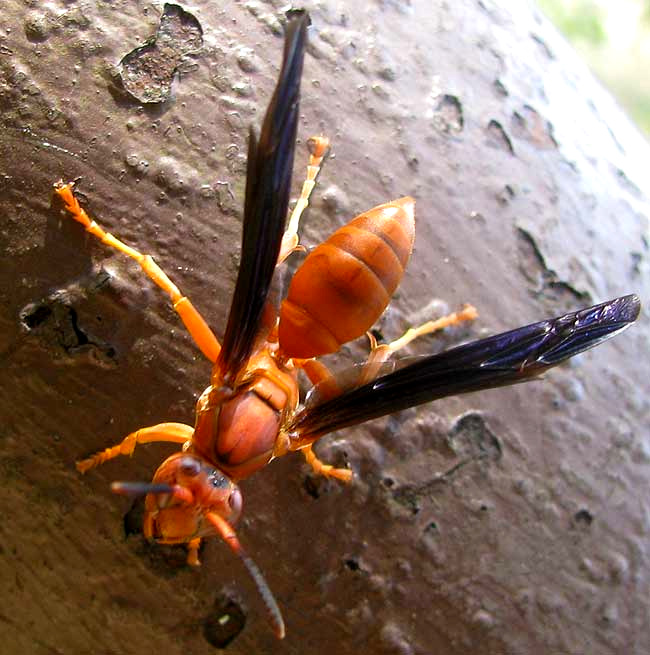Excerpts from Jim Conrad's
Naturalist Newsletter

from the July 1, 2012 Newsletter issued from the woods of the Loess Hill Region a few miles east of Natchez, Mississippi, USA
RED WASPS
Last weekend with my nature-photographer friend Jerry from Jackson I camped overnight at what's left of the abandoned campground at Pipes Lake {~N31.38°, ~W91.16°, elev. ~140ft (~40m)} in nearby Homochitto National Forest. A rusty pipe served as the campground's gate and the pipe had holes in just large enough to permit the entry of wasps, who apparently had built a nest inside. Several wasps clustered around the holes in defensive stance. That's one above.
I was tickled to get such a good picture of this wasp species because they've stung me so often, and I've always wondered who they are. Throughout this area these "red wasps" are famous for being so aggressive and inflicting such painful stings. In my whole life the only time I've been stung while asleep was by a red wasp.
Volunteer identifier Bea in Canada quickly came up with an ID. Its usual English name is Red Wasp, but two species are involved, which can only be distinguished from one another with certainty by looking at microscopic characters.
They are POLISTES CAROLINA and POLISTES PERPLEXUS*. Polistes perplexus seems to be a bit more southern in distribution, plus it tends to nest in more sheltered areas -- and inside that metal pipe was very sheltered -- while P. carolina is more likely to nest in the open, as under the eaves of a house.
Therefore, I'm guessing that the individual shown in the picture is most likely Polistes perlexus, but probably some of my more memorable stingings have been perpetrated by Polistes carolina. Both species occur throughout the US southeastern states and a bit beyond.
Thanks to help from a genuine wasp specialist, on the Internet one of the best discussions of the complex and interesting Polistes wasp life cycle and behavior is found on our own Backyard Nature Wasp page at http://www.backyardnature.net/wasps.htm.
from the May 26, 2002 Newsletter issued from the woods of the Loess Hill Region a few miles south of Natchez, Mississippi; elevation ~200ft (~60m), ~N31.42°, ~W91.41°; USA
AMBER WASP
You never know everything about anything. Probably a thousand times in my life I've been with people when a bee or wasp began buzzing around us, apparently looking for something sweet or wet. Often the other person would begin swatting at the creature and I'd say "Just be still, it won't sting you if you're still, but your swatting will make it think it's under attack and then it may indeed sting you... "
But the other day I was sitting perfectly still and had been still for several minutes, a wasp began buzzing around my head, I paid no attention, and then the thing stung me right on the forehead! It was a hard sting, too, staying sore for a couple of days.
Never in my life have I heard of anyone being stung who was sitting perfectly still. This just boggles my mind.
It was one of those amber-colored or orange wasps so common around buildings around here, but never found in the fields or woods. I've written here before that these are the most aggressive wasps I've ever known, a species I never saw when I lived in Kentucky, and Jarvis, my naturalist friend in North Carolina, says he doesn't know about them there. However, here they're likely to place their paper nests under the eaves of almost any building, and if you pass by their nest within ten feet, there's a good chance they'll sting you. But NEVER, I always thought, would they sting if you were sitting still.
I wish I knew what species this is. I've looked all over the Internet to no avail. If anyone even has a common name for these hostile, hair-triggered, bright-orange wasps I'd appreciate having it. I still have faith that other species will leave you alone if you don't antagonize them, but now I know that this orange species is something special...